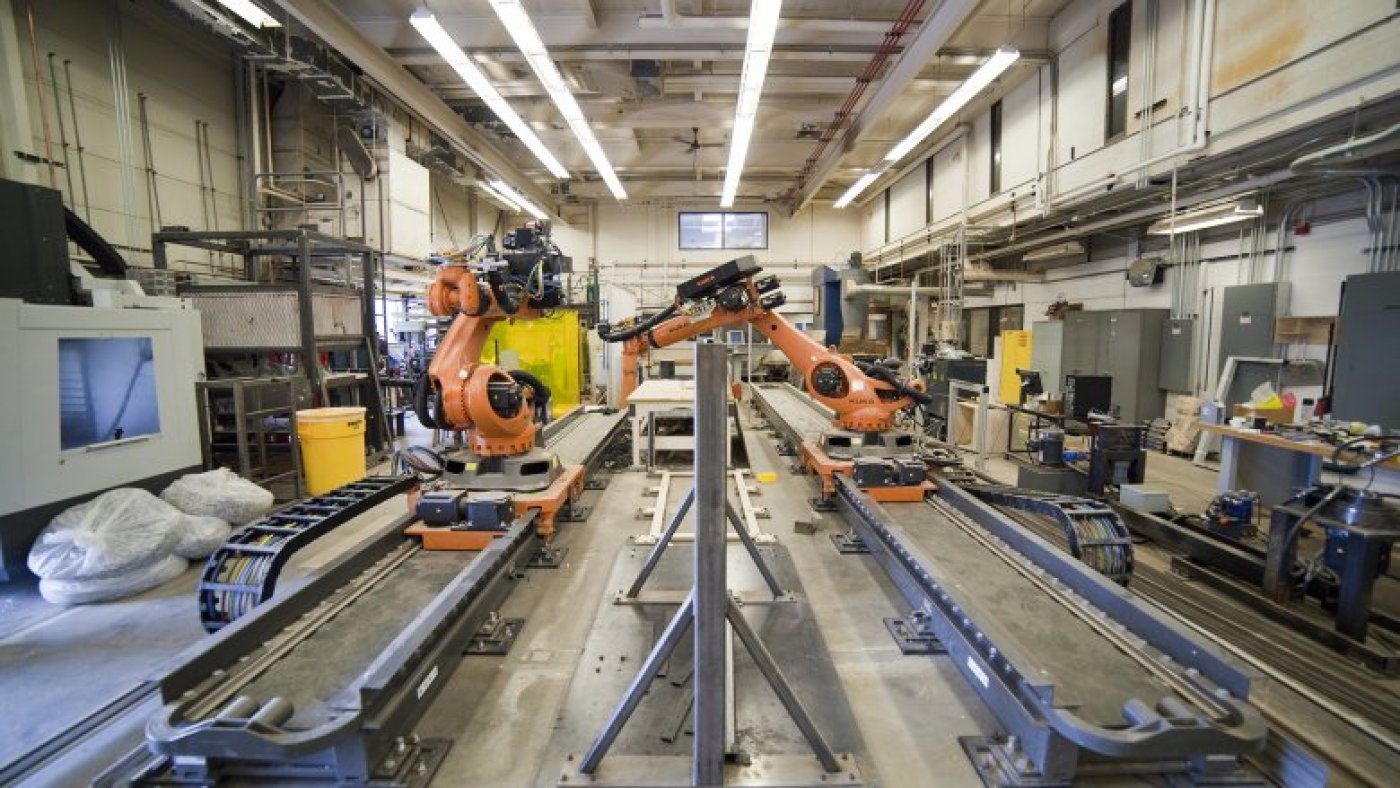The National Science Foundation (NSF) has awarded a grant totalling $2 million to an interdisciplinary research team, which includes Taubman College faculty Wes McGee and Arash Adel, to explore robotic partnerships in construction work.
The project, “Collaborative Research: Partnering Workers with Interactive Robot Assistants to Usher Transformation in Future Construction Work,” envisions that intelligent human-robot teams have the potential to increase productivity and streamline processes, thereby transforming the profile of future construction workers and resulting in new career opportunities and significant benefits to the industry.
The grant includes $1.58 million for a collaboration at the University of Michigan between Taubman College and the College of Engineering, as well as additional funds for external research partners at the University of Florida and Washington State University.
“Besides the direct benefits to the construction industry, this research has the potential to have a broader impact on our built environment,” said Adel, a co-principal investigator on the project and an assistant professor of architecture. “By taking advantage of the capabilities of the robots, such as their precision for performing construction tasks according to the digital blueprint of the building and their ability to perform nonstandard assembly procedures, this research might open up opportunities for the feasible construction of high-quality novel architectures that are too expensive or not feasible entirely with current construction practices.”
“This research builds on several years of collaborations between the Taubman College Robotics Lab and the Department of Civil and Environmental Engineering,” added McGee, a co-principal investigator on the project and an associate professor of architecture. “We have spent over a decade developing a digital twin environment to allow designers to interface seamlessly with digital fabrication and automation tools, and the next stage of this work will explore collaborative models of fabrication and assembly.”
The construction industry is ill-famed for its stagnant productivity, use of antiquated work processes, adversarial relationships among stakeholders, and safety and health issues among construction workers. Over time, this has led to a chronic shortage of skilled workers, largely due to an aging and retiring workforce and the reluctance of younger generations or people of different abilities to pursue such careers.
In this research, human workers will use interactive task learning technology to teach co-robots to perform construction tasks, resulting in symbiotic human-robot teams that can be widely deployed in the construction industry. The future human construction worker will be responsible for high-level work planning and will transition to the role of teacher and supervisor of the co-robot. The co-robot will perform physically strenuous tasks and collaborate with the human supervisor to improvise when unforeseen work conditions are encountered.
“It’s like the classical Master-Apprentice vocational model prevalent in today’s construction industry,” the team explained, “but instead of novice human workers developing skills by completing apprenticeships under the tutelage of skilled workers, the novices will be robots.”
This transition will be achieved through innovation in the construction vocational curriculum, where, in addition to learning fundamentals of construction work, human workers will learn and use new interaction, visualization, and trust development methods to collaborate with co-robots.
These new skills will enable workers to advance their work roles, encourage upward mobility, and open avenues for people of diverse physical abilities to be productive members of the construction workforce, a prospect that is impossible today. This will result in improved productivity and reduced costs associated with re-work and safety in construction work. ,
McGee and Adel’s fellow co-principal investigators are Carol Menassa (team lead), an associate professor of civil and environmental engineering; Vineet Kamat, a professor of civil and environmental engineering and electrical engineering and computer science; and Joyce Chai, a professor of electrical engineering and computer science; — each of whom is a leading expert in robotics and robots’ interactions with humans and the built environment. Other researchers on the project include Honglak Lee, U-M associate professor of electrical engineering and computer science; Jessie Yang, U-M assistant professor of industrial and operations engineering; Curt Wolf, managing director of the Urban Collaboratory in the U-M Department of Civil and Environmental Engineering; Denise Simmons at the University of Florida and Olusola Adesope at Washington State University.
McGee, an associate professor of architecture and director of Taubman College’s preeminent fabrication and robotics lab (FABLab), and the co-founder of Matter Design, is known for innovating in the space of design and fabrication across a range of material processes, particularly in the application of industrial robotic tools to architectural production.
Adel, an assistant professor of architecture and director of ADR Laboratory, is particularly known for his work with novel integrative computational design methods coupled with robotic assembly techniques for manufacturing nonstandard multi-story timber buildings.
“I am thrilled for this newest collaboration between architects and engineers, which will pilot future building methods to create economic opportunity and meaningful work,” said Taubman College Dean Jonathan Massey. “It’s an exciting new step in our research into construction and design innovation — and it exemplifies the far-reaching possibilities when Taubman College’s unparalleled expertise in digital design and fabrication is combined with the capacities of one of the world’s great research universities.”





